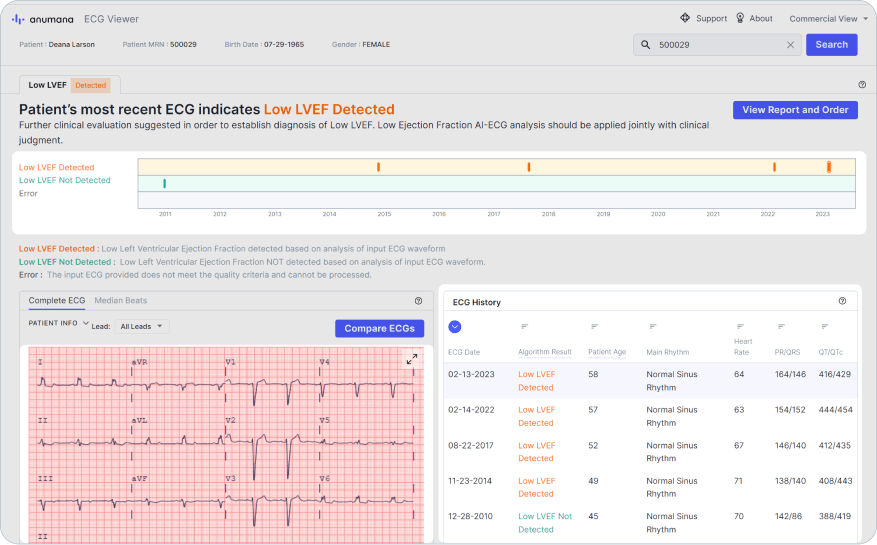Introducing ECG-AI™ LEF: FDA-Cleared AI Algorithm to Detect Low Left Ventricular Ejection Fraction
Breakthrough Software as a Medical Device (SaMD) to aid clinicians in detecting low ejection fraction (LEF) earlier than ever before
Our Breakthrough FDA-Cleared Algorithm
ECG-AI LEF: FDA cleared AI algorithm to detect low left ventricular ejection fraction


ECG-AI LEF is an algorithm developed in partnership with Mayo Clinic and nference

State-of-the-art deep learning model developed using over 100,000 ECGs and echo data pairs from unique patients

Evaluated in 25+ studies studies across multiple institutions in the U.S. and internationally

PHI secure and compliant, and seamlessly integrates into existing clinical workflows
Diagnose Heart Failure Earlier with ECG-AI LEF

Anumana's ECG-AI LEF can detect low EF earlier, without the onset of clear symptoms or conventionally identified ECG abnormalities
Heart failure is a progressive condition affecting over 6 million people in the U.S.1 Early intervention can improve outcomes, but detection of early heart failure is challenging as patients are often asymptomatic or present non-specific symptoms.2 Identification of patients with LEF (EF≤40%) can enable clinicians to intervene earlier and prevent the progression of the disease.3 An echocardiogram, while capable of diagnosing LEF, necessitates a clear indication of cardiac abnormalities for scheduling, often entails extended waiting periods, and demands significant resources, potentially resulting in diagnostic delays.
ECG-AI LEF represents a groundbreaking shift in ECG interpretation. The ECG is a widely utilized and swiftly administered test, used in both primary and specialized healthcare settings. While it generates intricate patterns across its 12 leads, the majority of clinicians and ECG analysis machines are trained to use simple sets of linear rules to identify signs of diseases. In early heart failure stages, ECG-AI's ability to detect subtle yet complex ECG patterns surpasses those of conventional interpretation standards.
References:
- Tsao CW, et al; on behalf of the American Heart Association Council on Epidemiology and Prevention Statistics Committee and Stroke Statistics Subcommittee. Heart disease and stroke statistics—2023 update: a report from the American Heart Association. Circulation. 2023;147:e93–e621. doi: 10.1161/CIR.0000000000001123.
- Attia, Z.I., Kapa, S., Lopez-Jimenez, F. et al. Screening for cardiac contractile dysfunction using an artificial intelligence–enabled electrocardiogram. Nat Med 25, 70–74 (2019). https://doi.org/10.1038/s41591-018-0240-2
- Heidenreich P, Bozkurt B, Aguilar D, et al. 2022 AHA/ACC/HFSA Guideline for the Management of Heart Failure. J Am Coll Cardiol. 2022 May, 79 (17) e263–e421. https://doi.org/10.1016/j.jacc.2021.12.012
ECG-AI™ LEF is Clinically Proven to Detect Low Ejection Fraction (LEF) Early
ECG-AI LEF is a highly effective screening tool for identifying low EF and has the potential to help clinicians uncover more LEF cases.
Designated as a breakthrough device by the FDA in 20192
Robust clinical data across a diverse patient population3
| Sensitivity | Specificity | |
|---|---|---|
| Overall | 84.5% | 83.6% |
Dataset diversity was representative of U.S. population
Neural Network of ECG-AI™ LEF is Well-Studied


Proprietary AI built on vast real world data
Pragmatic Clinical Study:4
The EAGLE study, a prospective, randomized trial, utilized an early device version of ECG-AI LEF, with the same neural network. This was used by 120 primary care teams across over 22,000 unique patient encounters. The study demonstrated a 31% increase in LEF detection compared to the standard of care alone, without increasing the utilization of echocardiography. Moreover, the majority of patients where LEF was detected received additional treatments.
Learn moreReferences:
- Attia, Z.I., Kapa, S., Lopez-Jimenez, F. et al. Screening for cardiac contractile dysfunction using an artificial intelligence–enabled electrocardiogram. Nat Med 25, 70–74 (2019). https://doi.org/10.1038/s41591-018-0240-2
- Fierce Biotech, https://www.fiercebiotech.com/medtech/mayo-clinic-ai-algorithm-proves-effective-at-spotting-early-stage-heart-disease-routine-ekg
- Anumana Data on File
- Yao, X., Rushlow, D.R., Inselman, J.W. et al. Artificial intelligence–enabled electrocardiograms for identification of patients with low ejection fraction: a pragmatic, randomized clinical trial. Nat Med 27, 815–819 (2021). https://doi.org/10.1038/s41591-021-01335-4
Easily Integrated into EHR and Clinical Workflow
Anumana’s ECG-AI LEF solution can be integrated with any ECG information management system or directly with any institution’s existing EHR on a zero-footprint dashboard (ECG Viewer).
ECG Viewer is a web based dashboard with a secure and compliant infrastructure that displays a patient’s ECG history and real-time ECG-AI results to support clinical decision making.

ECG-AI Results
Prior standard 12L ECGs and displays results in patient timeline
Integrated With Existing Work Flow

Category III CPT® Codes
Anumana received two Category III CPT® codes from the American Medical Association effective as of January 1 2023.
CPT® Category III codes are designed to facilitate the use, adoption, and potential reimbursement of emerging technologies. The approval of these codes is a major milestone for AI in cardiology, recognizing Anumana’s ECG-AI as innovative solutions necessitating the creation of a new procedure category.
Code | Description |
|---|---|
+0764T | Assistive algorithmic ECG risk-based assessment from concurrently performed ECGs. |
0765T | Assistive algorithmic ECG risk-based assessment from previously performed ECGs. |
Download Our One-Pager
Featuring key corporate highlights and an overview of Anumana's technology
@2025 anumana, Inc. All rights reserved.